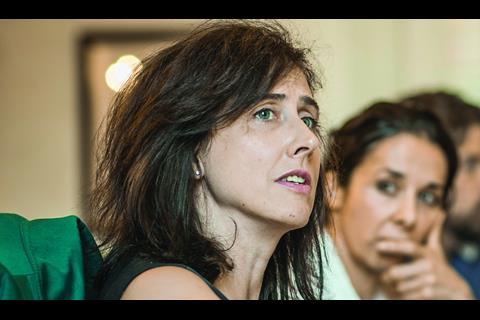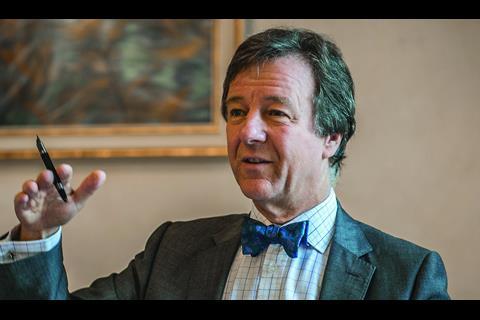At an LGC/HSJ roundtable, public health professionals and clinicians discussed tackling malnutrition with an integrated approach. Nic Paton reports
In December 2013, seven academics warned in a letter to The BMJ that hospital admissions for malnutrition in England had nearly doubled in the past five years and, if nothing was done about it, we would soon face “a public health emergency”.
‘The frustration for patients is they don’t work in the same neat boxes we do’
The stark warning highlighted complex societal and political issues, such as the effect of economic austerity on income and the rise in the use of food banks. But, as the NHS Institute for Innovation and Improvement has pointed out, the health consequences of malnutrition are already well known.
The institute has said there are about 3 million people in the UK at risk of malnutrition. It affects 10-40 per cent of patients in the community and 40 per cent of those in hospital. However, only a third of patients are screened for malnutrition on admission to hospital.
Malnutrition can increase mortality, morbidity and length of hospital stay. Malnourished patients are more likely to be discharged into a care home or need home care following discharge and they have a higher rate of hospital admissions, GP consultations and prescriptions.
An issue such as this, which so clearly crosses the boundaries between health, social and community care, should be a prime task to tackle in the integrated public health and social care system. However, as a joint Local Government Chronicle and HSJ roundtable discovered this month, malnutrition, especially among old and frail patients, remains overlooked.
Integrate and collaborate

The debate, supported by nutrition specialist Nutricia, brought together experts from primary and secondary care as well as local government. It focused on how better integration and collaboration could tackle and prevent malnutrition.
- Tim Allison, director of public health, East Riding of Yorkshire Council and secretary of the Association of Directors of Public Health
- Natasha Bye, public and strategic affairs director, Nutricia
- Dr Michael Dixon, GP and chair of the NHS Alliance and senior adviser, NHS Clinical Commissioners
- Nick Golding, editor, LGC (chair)
- Dr Berenice Lopez, former GP and consultant in metabolic medicine at Norfolk and Norwich University Hospitals Foundation Trust and adviser to the RCGP Nutrition Group
- Professor David Oliver, consultant in geriatrics and acute medicine, the Royal Berkshire Hospital, former “older people’s tsar” in the Department of Health, president-elect of the British Geriatrics Society and a member of HSJ’s Commission on Hospital Care for Frail Older People
Natasha Bye, public and strategic affairs director at Nutricia, said that too often malnutrition slips through the net, becoming “nobody’s concern” rather than “everybody’s concern”.
As a founder member of the government’s Malnutrition Taskforce, Ms Bye was concerned with how the industry, the NHS, social care, public health and non-governmental organisations could come together more seamlessly and effectively.
“Everyone is talking integration, and we tend to talk about it from the systems’ point of view but we know, from talking with our patients, that the frustration for them is they don’t work in the same neat boxes we do. They don’t see health, social care, and public health; they see all the different people they’ve got to phone up to help with the care of their mother,” she explained.
“We are trying to work out how you incentivise people to work together so it becomes a reality. What are the barriers to break down to make that happen?” she added.
‘Fluffy’ perception
Dr Michael Dixon, GP and chair of the NHS Alliance, highlighted two barriers: that nutrition is too often seen as “fluffy” rather than as a mainstream health or public health priority, and that public health commissioning and decision making is often divorced from the front line.
‘Some of it is not about integration; it’s about every health and care professional being aware of how to screen for malnutrition’
“It seems to me that, to square the circle of integration, you’ve got to have me, as a frontline practitioner, linked into the commissioning decisions, whether it be tube feeding or simply what we’re going to do with local populations in terms of improving local health,” he said.
“Commissioning needs to be predicated on the individual clinician and individual patients, which to some extent clinical commissioning is about. But also we need to have local health champions who will start to talk to this agenda. At the moment a lot of clinicians do not see it as their territory; public health is in ‘outer space’ and therefore things are not connected,” he added.
Often the public health focus within nutrition is on obesity, especially among children, rather than on malnutrition, conceded Tim Allison, director of public health at East Riding of Yorkshire Council and secretary of the Association of Directors of Public Health.
“There is certainly a challenge about how to get that link between what goes on strategically - a perception of public health being a long way away - with getting down to the local practitioners,” he said.
Local government’s public health remit, as well as its role in commissioning social care, meant it potentially had the opportunity “to set policy and to have that policy implemented on the ground”, he added.
Awareness to screen
Those who are malnourished or are at risk are mainly people aged over 75; in sheltered accommodation or in receipt of social care services; people with recurrent hospital admissions; people in nursing homes and both older people and mid-life adults living with complex, long term conditions, pointed out Professor David Oliver, consultant in geriatrics and acute medicine at the Royal Berkshire Hospital.
‘There is consensus that we need to pick up early and where possible intervene early. It is just about how you make it happen’
“The majority of those individuals will be in contact with one or more health and care services in a given year; most of them will be on someone’s radar. If we start doing risk stratification and case finding, even more so. Some of it is not about integration; it’s about every health and care professional who comes into contact with people being aware of how to screen for malnutrition, which services to refer to and then having enough capacity actually to monitor people,” he said.
“I’d be interested to see, if there has been an assessment of how consistently nutrition is placed in joint service needs assessments across the country. Is it something that’s recognised and is there a consensus that this is something that needs to be addressed across each locality?” said Dr Berenice Lopez, former GP and consultant in metabolic medicine at Norfolk and Norwich University Hospitals Foundation Trust.
“That is one of the problems; there are some areas where it is being looked at but I don’t think it is being universally adopted. An assessment of where nutrition sits in each joint service needs assessment would be a good place to start,” she added.
Ms Bye said the government’s Malnutrition Taskforce, of which Nutricia is a founding member, has helped to bring together a lot of practitioners from different disciplines. One of the taskforce’s primary goals was to encourage “whole communities” - local NHS trusts, hospitals, GP practices, care homes and community groups - to work more closely together.
The taskforce has begun to test how different whole community approaches might work on the ground, with pilots running in Gateshead, Salford, Kent, Purbeck in Dorset, and Lambeth and Southwark. These were still at a very early stage, but will be watched closely, our participants agreed.
“For me it is the implementation,” said Ms Bye. “There is consensus this is an issue we need to pick up early and where possible prevent and intervene early. It is just about how you make it happen.
“We’ve shared a lot of this with CCGs and everyone sees the case for change. It’s just that leap of actually making it happen because it is a big challenge when you’ve got to manage budgets, and [think about] how you’re going to implement this. Is it measured and is it tracked?” she added.
Screening comparison
This issue of how malnutrition is measured and screened for compared with more “concrete” conditions such as, say, fractures was discussed.
‘Could you get the big supermarkets interested? Except for one, no. It wasn’t going to increase their profits’
Dr Lopez said: “GPs are aware of unintended weight loss being a red flag for serious disease, so there is that awareness. They’re not aware that malnutrition can be a risk factor for chronic disease. They see it as a red flag, ‘oh I need to look for cancer, oh I need to look for serious disease’. But they don’t think the other way around and think the malnourished person sitting there in front of them a few years down the line could be the person with other problems.”
“Screening, unless it is linked to action, means very little, so there has to be the follow-up,” said Ms Bye.
“It is having the conversation with the patient to say why they may be at risk, so that you are educating the person themselves about what action they can take. If they are prescribed a supplement or having to have a tube feed they must be educated on how to do that safely and to know what other things they can do.”
The discussion tackled the lack of a robust evidence base for intervention in this area, including the role and usefulness of National Institute for Health and Care Excellence quality standards and clinical guidelines. There was debate too about who would be best placed to raise awareness and effect change.
GPs, carers, home care workers and community and district nurses were all mentioned as possible agents of change. The private sector, either in the shape of private providers or more widely, also had a role to play, Dr Dixon said.
For example, he highlighted the frustration he had felt in trying to involve supermarkets with the public health agenda on diabetes by offering educational talks and advice on food.
“Could you get the big supermarkets interested? Except for one, no. They said it wasn’t going to increase their footfall or their profits,” he said.
Role of wellbeing boards
The group discussed the role of health and wellbeing boards and agreed that in time these could set the agenda for public health within the local community. Dr Dixon said: “Commissioning is probably the most powerful way of spreading good practice if it is connected.”
‘GPs are aware of unintended weight loss being a red flag for serious disease. They’re not aware that malnutrition can be a risk factor for chronic disease’
He argued that to create a clearer picture of malnutrition on the ground the sector had to ensure CCGs were better connected to frontline clinicians and district nurses, and that GPs were not just informed about malnutrition but saw it as a priority.
“I’ll know who I need to identify, what I can do about them and hopefully not be told off by my colleagues for over- or underprescribing. It is a question of health and local authority connection, planning and implementation; connection between the chiefs and the frontline,” he explained.
“The real problem is that people see the nutritionist as the person who does nutrition and public health as the people who give out the orders. For everyone else, it’s everyone else’s problem. The first thing you need to do is make it absolutely intrinsic to the hindbrain of every nurse, doctor and healthcare assistant that we should all see this as a priority,” he added.
Dr Lopez also emphasised the importance of nutrition being discussed during the transition from secondary into primary or community care. Weight loss could often be overlooked on discharge summaries, leading to a vicious cycle of unintended weight loss and subsequent readmission. “You can focus on what’s going on in the acute sector or primary care but, actually, it’s at the interfaces of care where people fall down,” she said.
“There is a lot of emphasis on screening when patients are admitted into hospital but there is much less of an awareness of the importance of communicating any issues around nutrition or hydration as patients move back into their homes or into a care home,” she added.
“It has to be more than a piece of paper; it has to be person to person, often nurse to nurse,” added Dr Dixon.
Ensuring care transitions
In summary, Professor Oliver said: “If we’re focusing on the people who are already malnourished or at risk, the biggest bang for your bucks will be making sure that at every point where they come into contact with the system it’s on people’s radars to think about their nutritional status. At the moment we’re not systematically identifying these patients.”
Dr Lopez added: “We must also ensure care transitions. Information about the patient’s nutritional status must be highlighted when patients are moving between care settings, particularly between the acute sector and the community when patients are discharged earlier in their recovery process. There is also a lot of myth busting to be done around malnutrition, ie: that it is not a normal part of ageing or an irreversible part of a disease.”
“From a public health point of view it is important to raise awareness of the prioritisation of malnutrition. There is quite a long way to go with that. The rest of it is coordination, both at a strategic and an operational level and we must make sure there are people tasked with implementing appropriate levels of nutrition,” argued Mr Allison.
Nutricia’s Ms Bye concluded: “Malnutrition is a cause and a consequence of disease. There could be far better awareness among all different professionals, not just the obvious candidates but within community practice, within hospitals and within care homes to identify the signs and recognise if the weight loss is unintended.
“I would also like to see that there is some way of tracking and measuring nutrition which links into meaningful outcomes; that we can take nutrition from a ‘fluffy’ space into something that is really at the heart of health, social care and public health.”
Kate Hall: Offer the right nutritional care at the right time
Malnutrition is both a cause and a consequence of disease. A report by British Association for Parenteral and Enteral Nutrition, and Patients on Intravenous and Neogastric Treatment in March 2014, Nutritional Care and the Patient Voice, confirmed the lack of progress in improving care for vulnerable patients with complex nutritional needs.
‘Malnutrition can only be managed if there are the right policies in place’
Malnutrition can only be managed if there are policies in place which are followed and reviewed. The National Institute for Health and Care Excellence’s clinical guidance 32 concludes: “Improving systematic screening, assessment and treatment of malnutrition would result in better nourished patients and… reduced complications, admissions, and length of stay.”
NICE says that if implemented, this guidance could achieve savings of £78,000 per 100,000 people. Support must be tailored to patients’ needs, which might mean nutritional advice, oral supplements or enteral nutrition. It is important to intervene early and monitor outcomes.
Nutricia strives to ensure people consistently receive the right nutritional care at the right time. It is estimated that three million people are malnourished or at risk in the UK. This, combined with an ageing population and an increase in conditions associated with malnutrition, such as dementia, means the challenge of addressing this issue has never been greater.
‘Malnutrition puts pressure on the whole health and care system, and it should be prioritised with a true integrated approach’
We need prevention and management strategies to help people remain independent for longer. Nutricia actively raises awareness and works with others on solutions. It has worked with Carers UK to help carers to understand good nutrition. This partnership aims to “ensure the best quality of life and nutritional care for you, your family and the people you look after”. It demonstrates of how a provider can work with the third sector to ensure good nutritional care.
Nutricia is a founding member of the Malnutrition Task Force, a group of experts from health, social care and local government, which addresses malnutrition in older people. It has ministerial support and representation from a wide range of professional organisations, care home providers, community meal providers, charities, NGOs and the International Longevity Centre.
In May 2013, it launched four guides under the title Prevention and Early Intervention of Malnutrition in Later Life, covering all of the care settings (local communities, hospitals, care homes) and also food and beverage providers. It also published a report entitled Impact of Malnutrition and Cost Benefits of Intervention. It is now executing five UK pilot projects designed to improve nutrition.
There are well recognised guidelines in place from NICE and the Managing Adult Malnutrition Community pathway. Malnutrition puts pressure on the whole health and care system, and it should be prioritised with a true integrated approach that means health, social care, the industry and voluntary sectors all working together, focused on providing the most appropriate care, including nutrition for the individual wherever they are living.
Kate Hall is external and public affairs manager at Nutricia Advanced Medical Nutrition
































No comments yet